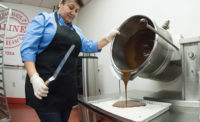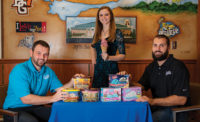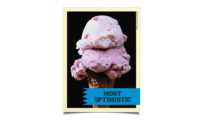Large signs touting “Toft’s ‘One Quality’” and “Ohio’s Oldest Dairy” greet visitors to Toft Dairy’s 74,500-square-foot dairy plant/headquarters facility in Sandusky, Ohio. Those two messages amply describe the family-owned company’s heritage. After all, Toft Dairy, guided by five generations of the Toft and Meisler families, has been producing consistently high-quality dairy products for 119 years (see Processor Profile, page 44). And ice cream is a big part of that quality product mix, with the frozen treat accounting for almost half of the plant’s production.
Like the company’s overall operations, plant operations are a family affair. Assistant Vice President Josh Meisler, a fifth-generation family member, is the ice cream production manager. And fourth-generation family member Denny Meisler is the plant manager and a company vice president.
From tanker truck to freezer
The plant produces approximately 70 flavors of ice cream under its own Toft’s brand; it also is a contract manufacturer for some other ice cream brands. The ice cream is packed in single-serve cups for schools and institutions; pint containers, 48-ounce scrounds and half-gallon cartons for retail; and 3-gallon tubs for scoop shops and foodservice, Josh Meisler noted. Local residents can taste most of those flavors in the on-site Toft’s Ice Cream parlor, which is open to the public seven days a week.
Ice cream production takes place in one staggered shift, five days a week. Although the milk side of operations is visible from the ice cream side, each side has its own dedicated production team, Josh Meisler explained.
Production begins with the arrival of fresh milk; the facility receives approximately 10 tanker truck loads a week from family farms that are no more than 60 miles away, Josh Meisler said. Incoming milk is pasteurized, homogenized and standardized for the recipe.
After the base mix is chilled, it is transferred to one of the plant’s six ice cream holding/mix tanks. From there, the base mix is conveyed into one of five flavoring tanks. The flavored mix then enters one of the facility’s three freezing units, where a cold temperature and air whip it into a traditional ice cream consistency.
Many of the ice cream varieties then go through a variegate feeder and an ingredient (inclusion) feeder before they are conveyed to one of two filler lines. (During Dairy Foods’ visit, the plant finished up a run of Toft’s Vanilla ice cream and then started up production of Toft’s Birthday Cake ice cream.) One line is used for half-gallon, 48-ounce, 5-quart and 3-gallon containers, Josh Meisler noted, while the other line can handle 3-ounce single-serve and pint sizes (and anything in between). The 3-gallon ice cream tubs are the only containers filled by hand.
After filling, the containers get lids and are automatically bundled according to size. During Dairy Foods’ visit, 4-ounce single-serve cups of Vanilla ice cream were being packaged 24 to a box, while half-gallons of Birthday Cake ice cream were being packaged in shrink-wrapped bundles of four.
Finished ice cream products then are automatically conveyed to a hardener, Josh Meisler explained, before they are palletized and transferred to the facility’s storage freezer.
Quality is everything
To stay true to its “Toft’s ‘One Quality’” promise, Toft Dairy uses only the finest ingredients in its products, explained Rebecca Schatzinger, food safety and quality manager.
“With this [One Quality] philosophy, we put quality as our No. 1 priority,” she stressed. “This philosophy is a part of our culture, and we often include the phrase in our logo.”
Toft Dairy also relies on stringent food safety practices to protect product quality. The plant’s employees follow good manufacturing practices, Schatzinger noted, and also segregate allergens.
“We physically separate the allergenic ingredients — flavorings, colorings, variegates, inclusions, etc. — from the non-allergenic by storing them in different locations,” she said.
In the cooler’s hallway, the buckets containing raw ingredients are monitored so that any leaks or residues are cleaned up before there is cross-contact with non-allergens.
The facility even has guidelines in place for broken pasteurized eggs, Schatzinger added. If breakage occurs, then plant personnel dispose of the cleaning tools following cleanup.
“This prevents allergenic proteins and pathogens such as salmonella from spreading through the facility,” she noted.
The plant also holds the family farms from which it sources its milk to a high standard. It sends the producers’ milk to a third-party laboratory to be tested for aerobic plate count bacteria, preliminary incubation count and somatic cell count.
“As for somatic cell, the state’s written standard is that the counts must be equal or less than 750,000 colony-forming units per milliliter,” Schatzinger said, “but we expect equal to or less than 400,000.”
On the equipment side, the plant relies on verification programs using adenosine triphosphate to check the effectiveness of cleaning and sanitation, she said. It also performs food allergen testing — the testing is able to detect specific proteins at the 5-parts-per million level. A third-party lab, meanwhile, tests environmental swabs for listeria and salmonella.
As an extra precaution, Toft Dairy performs a plantwide audit each month, where a Preventive Controls Qualified Individual (PCQI) walks through the facility to look for sources — or potential sources — of contamination, Schatzinger noted.
“The PCQI will look for things such as unsanitary personnel practices, water leaks or pooling water, unclean surfaces and unsafe working conditions,” she explained. “The auditor will then notify the proper management to fix the items that were found.”
And on the supplier side, Toft Dairy relies on its Approved Supplier program, which calls for ingredients to be rigorously tested before they are shipped.
“We also make sure that the ingredients we purchase have been made or sold in a facility that has all the required paperwork and can be easily traced to the manufacturer,” Schatzinger said.
In addition, the company has an annual verification program for suppliers, which starts with sending to each supplier a questionnaire soliciting key information.
“We look over our suppliers’ recent audits, review policies, review their critical control points and review allergenic and nutritional information on their products,” Schatzinger said. “We also look for certified documents such as kosher certificates, GMO statements and any safety data sheets. … If our suppliers receive components for their products from a foreign company, they must provide additional documentation to follow Food Safety Modernization Act regulations.”
A robust product-testing program
Safeguards aren’t limited to equipment and incoming milk and ingredients, of course. Toft Dairy thoroughly tests the ice cream itself at different stages in the production process.
Before releasing the initial mix for production, the plant pulls a sample from each mix tank, testing it for aerobic plate count bacteria and coliform bacteria in its in-house lab, Schatzinger pointed out. If the mix happens to be dairy-free, the plant tests it for milk (an allergen) before the mix is allowed to continue the production run.
The facility then pulls samples from the production line, she noted. If the product is a single-serve cup or a pint container, three finished products are pulled from the line at the beginning of the run. For half-gallon or scrounds, a finished product container is pulled at the beginning of the run; for 3-gallon tubs (which are hand-packed), finished product is transferred to a sterile sampling bag at the beginning of the run.
Samples are tested in-house for bacteria and are rated either “pass” or “fail,” Schatzinger explained.
“If it passes, it continues through the process as normal,” she said. “If it fails, the sample is retested in triplicate to confirm or refute the original result. If all three tests are within specification, the original ‘failed’ result is discarded. If one or more of the triplicate tests are out of specification, the original result is confirmed.”
In addition, facility personnel might perform allergen testing on the finished product to ensure no allergen cross-contact occurred, she said. And to ensure that finished products retain their high quality, the plant monitors the storage freezer temperature carefully.
“Once all testing is complete, the food safety and quality manager approves or rejects the product for sale,” Schatzinger added.
Ensuring employee competence and safety
Quality-minded procedures and protocols are only as good as the people who perform them, of course. So Toft Dairy has programs in place to thoroughly train plant employees, as well as to keep them safe.
Plant team members are cross-trained to work on different lines/processes within a department, noted Richard Shafer, human resources manager.
“On occasion, team members will cross between the ice cream and milk departments to assist when staffing is impacted,” he added.
On the employee safety front, the plant utilizes safety features such as machine safeguarding on processing equipment, Shafer noted. And employees are trained on safety basics.
“Toft Dairy currently provides on-the-job training of safe operating procedures,” he said. “Toft’s does use a third-party trainer for forklift operation and licensing.”
And enhancements related to employee training are in the works. Toft Dairy’s human resources department is in the process of implementing innovative Human Capital Management (HCM) software to improve its overall program management, Shafer said. The software also will boost company engagement with current team members and team members undergoing the company onboarding process.
“The company policy handbook, work rules and training, including food safety, occupational safety and general health and safety awareness, will be delivered with greater efficiency and a more strategically managed process,” he pointed out. “Recently, Toft’s implemented a zero tolerance strategy toward our food safety policy, which reinforces compliance against policy violations.”
The HCM software potentially will help deserving plant employees grow in their careers, too, Shafer suggested.
“Many Toft Dairy employees have been with the company for many years, starting in entry-level positions or working full-time in the ice cream parlor,” he said. “These employees have advanced into full-time positions, including in the offices, as ice cream and milk production leaders, and as leaders within the dairy store. With the implementation of the HCM software, team members will be defining annual goals and individual development plans.”
Reducing waste, energy use
Toft Dairy is very engaged within the extended community in which it operates, partnering with local towns and organizations to create ice cream flavors unique to them and even running a Teacher of the Month program tied to local schools. So it should come as no surprise that the company strives to be a responsible citizen via sustainability-minded efforts.
One sustainability initiative aims to reduce food waste via larger production runs, Schatzinger explained.
“When we have larger runs, we are more efficient, and we can manipulate the ice cream mix so that we have exactly enough inclusions or flavoring for the mix,” she said. “Along with the larger production runs, we have fewer allergen changeovers, less shutdown time and less flushing of equipment. This reduces waste usually created at the beginning and end of the production run.”
And instead of disposing of the 5-gallon containers holding ingredients, Toft Dairy cleans and resells them, Schatzinger said. The plant also recycles wood pallets, reuses any plastic pallets and recycles its cardboard. In fact, the facility added a cardboard compactor to reduce the number of trips — and related gas needed — to transport the cardboard to the recycling firm.
On the energy side, the facility made the switch to LED lighting several years ago, she noted.
“The payback was quick with energy savings, and it had an additional cost savings by having fewer fixtures to replace,” Schatzinger said.
But the most impressive sustainability-minded investment, perhaps, is a wind turbine the facility installed about a decade ago.
“Every month, the turbine saves the company around $2,500 off our energy bill,” Schatzinger pointed out. “It’s something truly unique to the area and can be seen from a distance.”









